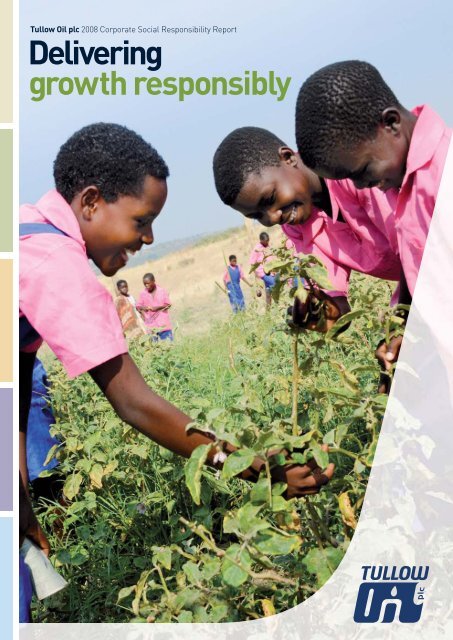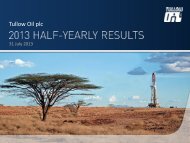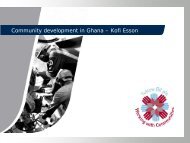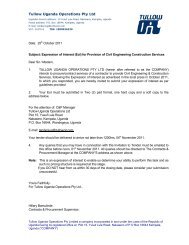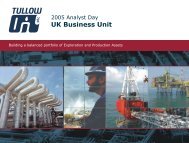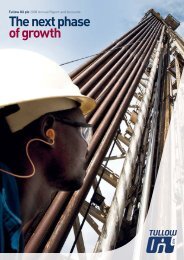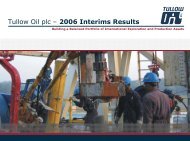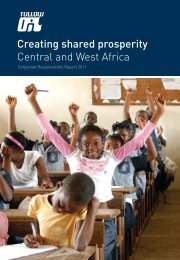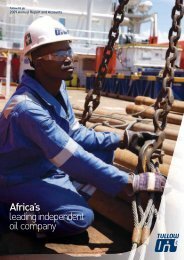Download the CR Report PDF - Tullow Oil plc
Download the CR Report PDF - Tullow Oil plc
Download the CR Report PDF - Tullow Oil plc
Create successful ePaper yourself
Turn your PDF publications into a flip-book with our unique Google optimized e-Paper software.
<strong>Tullow</strong> <strong>Oil</strong> <strong>plc</strong> 2008 Corporate Social Responsibility <strong>Report</strong>Deliveringgrowth responsibly
Delivering <strong>the</strong> next phase ofEightKey objectives achieved during 2008We set ourselves challenging goals to drivecontinuous improvement across <strong>the</strong> business.Read more on page 8ZeroSignificant environmental incidentsBuilding on our excellent track record, we had nosignificant oil or chemical spills during <strong>the</strong> year.Read more on page 100.54Lost Time Incident Frequency Rate (LTIFR)Our best safety performance ever, during a yearwith a significant increase in operational activity.Read more on page 14Trinidad and Tobago 4 (E)Guyana (E)Suriname (E)French Guiana (E)46%Increase in employees in 2008Despite a shortage of skilled workers in <strong>the</strong> industry,we continue to attract talented new people to <strong>Tullow</strong>.Read more on page 1795%Increase in voluntary social investmentOur Working with Communities initiatives contributeto and support <strong>the</strong> communities where we work.Read more on page 19What we do<strong>Tullow</strong> is one of Europe’s leading independent Exploration and Production (E&P) companies andoperates a versatile and balanced worldwide portfolio of quality oil and gas assets, managedby a team with excellent technical, commercial and financial skills. We have interests in 86licences across 22 countries, which include production from eight countries, world-classdevelopment projects in Ghana and Uganda and an extensive portfolio of exploration assetswhich offer long-term growth opportunities.Africa<strong>Tullow</strong> is poised to deliver on major projects in Ghana and Uganda in <strong>the</strong> short-term. For <strong>the</strong>longer-term, <strong>the</strong> Group has a strong exploration portfolio across 11 countries. Expertise in coreplays and a focus on execution creates <strong>the</strong> opportunity for fur<strong>the</strong>r material exploration upside.Rest of <strong>the</strong> World<strong>Tullow</strong> has a significant asset base in Europe, South Asia and South America. The Group has wellestablished production in <strong>the</strong> UK and Bangladesh, and exciting high-impact exploration acreagein Portugal, Pakistan, French Guiana and Guyana. We are targeting plays similar to <strong>the</strong> prolificJubilee field in Ghana across <strong>the</strong> Atlantic in South America to form part of future campaigns.
growth responsiblyUnited Kingdom (EDP)Ne<strong>the</strong>rlands (E)Portugal (E)Mauritania(EDP)Senegal (E)Pakistan(EDP)India 3 (E)Bangladesh(EDP)Côte d’Ivoire (EDP)Cameroon 1 (E)Liberia 2 (E)Ghana (ED)Equatorial Guinea (DP)Uganda (ED)Gabon (EDP)Congo (Brazzaville) (DP)Congo (DRC)(E)Tanzania (E)Angola (E)Namibia (D)Madagascar (E)Key: E Exploration D Development P Production1 <strong>Tullow</strong> sold its interest in Cameroon in mid-2008.2 <strong>Tullow</strong> acquired interests in Liberia in early 2009.3 <strong>Tullow</strong> withdrew from India in early 2009.4 <strong>Tullow</strong> withdrew from Trinidad and Tobago in early 2009.Group66,600 boepdWorking interest production825 mmboeTotal reserves and resources£692 millionSales revenueAfrica41,150 boepdWorking interest production745 mmboeTotal reserves and resources£476 millionSales revenueRest of <strong>the</strong> World25,450 boepdWorking interest production80 mmboeTotal reserves and resources£216 millionSales revenueGlossaryCSR Corporate Social ResponsibilityEHS Environment, Health and Safety
As <strong>Tullow</strong> <strong>Oil</strong> enters its next phase of growth, we arefocused on ensuring that this growth is deliveredresponsibly. Our business is becoming larger and morecomplex but our core principles remain <strong>the</strong> sameand we recognise that corporate social responsibilityis a major contributor to our success to date.Managing our responsibilitiesMinimising our environmental impactsWorking safely to best industry standardsDeveloping and engaging with our peopleWorking with local communitiesThis report has been reviewed by <strong>the</strong> Global <strong>Report</strong>ing Initiative (GRI), which confirms it has metall ‘C+’ level reporting requirements, including external assurance. The GRI content index for <strong>the</strong>report is available in <strong>the</strong> online version of this report. Visit: www.tullowoil.com/tlw/crFront cover: School vegetable garden project, Kaiso-Tonya, Uganda.
Contents2 Chief Executive’s introductionDelivering <strong>the</strong> next phase of growth responsiblyis fundamental to our long-term development.4 A sound approachStrong leadership at corporate, country and operationallevel drives our business sustainability agenda.6 Progress and performance2008 was a record year for CSR and EHSperformance, reflecting continuous improvementthroughout <strong>the</strong> Group.8 Managing our responsibilitiesWe undertake an economic, environmental and socialduty of care in all aspects of our business.10 Minimising our environmental impactsWe have comprehensive systems and processes in place tomanage environmental issues across our global operations.14 Working safely to best industry standardsWe achieved a very strong health and safety performancein 2008; one of our key EHS objectives for <strong>the</strong> year.17 Developing and engaging with our peopleWe have strong initiatives to develop talent throughout<strong>Tullow</strong>, ensuring that everyone reaches <strong>the</strong>ir full potential.19 Working with local communitiesWe strive to make a significant difference to <strong>the</strong> localcommunities where we work.22 Supplementary information23 Global <strong>Report</strong>ing Initiative (GRI)24 Assurance statement25 Get more onlineFor more information on <strong>Tullow</strong> <strong>Oil</strong> <strong>plc</strong> andCSR activities visit: www.tullowoil.comWe welcome your feedback. Please provide your comments tocsr@tullowoil.com or go online to www.tullowoil.com/tlw/cr/feedback<strong>Tullow</strong> <strong>Oil</strong> <strong>plc</strong> 2008 Corporate Social Responsibility <strong>Report</strong> 1
Aidan Heavey, Chief Executive Officer at <strong>Tullow</strong>’s golf day.Delivering <strong>the</strong> next phaseof growth responsiblyAn exceptional year2008 was a very successful year for <strong>Tullow</strong>. We matchedunprecedented exploration success with significant progresstowards <strong>the</strong> development of two major new oil provinces inGhana and Uganda. We delivered record financial results,driven by a strong operational performance and higher oiland gas prices. Our staff base grew by almost 50% and weopened a number of new offices in Africa. We also achievedexceptional Health and Safety (H&S) performance and hadno significant environmental incidents across <strong>the</strong> Group.Overall, we performed well against our Key PerformanceIndicators (KPIs) and full details of <strong>the</strong>se and our performanceand prospects are set out in <strong>the</strong> 2008 Annual <strong>Report</strong>and Accounts.Strategic managementNotwithstanding record levels of operational activity and ourrapid pace of growth, we remain very committed to managingour social and environmental impacts, as well as acting withintegrity. We continue to be transparent and accountablealong with complying with local legislation and industrybest practice. Behaving responsibly in <strong>the</strong>se ways maintainsour excellent reputation and enables us to foster and buildtrust with our stakeholders.Our contribution to <strong>the</strong> welfare of <strong>the</strong> communities closeto our operations helps us earn our social licence tooperate. It is also a means of strategically managingrisk in challenging operational and social environments.Our ‘Working with Communities’ (WwC) investmentis closely aligned with <strong>the</strong> United Nations MillenniumDevelopment Goals, which are aimed at alleviatingpoverty, improving education and health standards,and promoting equality.Our most important resourceWe invested a lot in our people throughout <strong>the</strong> business in2008, with a number of key new roles including a ChiefHuman Resources (HR) Officer. As a result, we launched aGroup-wide HR strategy during <strong>the</strong> year including a strongprogramme for training and development, which remains acore component of our business strategy. We implementeda ‘T for Talent’ programme, designed to ensure that all ourstaff have <strong>the</strong> opportunity to achieve <strong>the</strong>ir full potential.Additionally we recognise our responsibility to share ourexperience and skills, in particular to assist with nationaldevelopment plans in countries with emerging E&Pindustries. In 2009, we welcomed 14 secondees from <strong>the</strong>Ghana National Petroleum Corporation (GNPC) to <strong>Tullow</strong>and will work with <strong>the</strong>m over <strong>the</strong> next two years to build<strong>the</strong>ir skills and understanding of <strong>the</strong> industry. We havecommenced an active recruitment drive as part of ourcommitment to employing 90% local staff in Ghana by 2018.Ready to deliverIn this report, we have outlined <strong>the</strong> material aspectsof our CSR and EHS responsibilities and detailed <strong>the</strong>2 <strong>Tullow</strong> <strong>Oil</strong> <strong>plc</strong> 2008 Corporate Social Responsibility <strong>Report</strong>
“Our contribution to <strong>the</strong> welfareof <strong>the</strong> communities close toour operations helps us tobuild trust and in turn earnour social licence to operate.”initiatives we are undertaking. In addition, to improveour accountability we have increased <strong>the</strong> scope of thirdparty data assurance and followed <strong>the</strong> Global <strong>Report</strong>ingInitiative G3 Guidelines.The leading E&P companyRealising our vision of being <strong>the</strong> leading independentE&P company can only be achieved by embeddingclear values and responsible practices across <strong>the</strong> Group.2008 was a great year for <strong>Tullow</strong> and, while it is goodto celebrate success, we must focus on <strong>the</strong> future toensure that we continue to live up to <strong>the</strong> standards thatwe expect of ourselves and that are expected of us.Undoubtedly <strong>the</strong>se are challenging economic andfinancial market circumstances, but <strong>Tullow</strong> is verywell positioned to continue to prosper. 2009 will beano<strong>the</strong>r busy year as we seek to deliver <strong>the</strong> next phaseof growth responsibly, in what is a very exciting andtransformational phase for <strong>the</strong> Group.Aidan HeaveyChief Executive OfficerNominated Director with CSR and EHS responsibilityOur visionOur vision is to be <strong>the</strong> leading global independentexploration and production company. We willachieve this by:• Building on our excellent track record throughbeing <strong>the</strong> best in all that we can do;• Continuing to grow value over <strong>the</strong> long-term as partner,operator and employer of choice; and• Conducting our operations with respect for <strong>the</strong> peopleand environments where we work.Our valuesThe Group’s core values that support <strong>the</strong> pursuitof our vision remain unchanged. They are:• To respect <strong>the</strong> countries in which we operate;• To contribute to and support local communities;• To manage environmental and business risks;• To empower and support <strong>the</strong> individual;• To value and foster long-term relationships; and• To be transparent in our activities and reporting.Our strategy<strong>Tullow</strong> pursues a consistent and repeatableGroup strategy that seeks to deliver sustainablelong-term growth, with a balance between funding,exploration and production spend, and majoractivities in core areas.Our Group strategic objective is to deliver topquintile Total Shareholder Return versus ourindustry peer group.Our CSR strategy is integral to delivering ourGroup strategy and CSR is embedded across<strong>the</strong> business in key ways, such as:• Clear policies, processes and procedures throughout<strong>Tullow</strong>;• Strong social and community investment programmesthrough our WwC initiatives;• Continuously improving our health and safetyperformance, even in times of rapid growth;• Minimising and managing <strong>the</strong> environmental impactof our operations; and• Ongoing and significant investment in our peopleand organisation.VisionValuesDeliveringgrowthresponsiblyGroup strategyLearn moreThere is a lot more information in <strong>the</strong> 2008 Annual<strong>Report</strong> and Accounts on how we are realisingour vision, executing our strategy, running ourbusiness and measuring our progress.Go online at http://www.ara2008.tullowoil.comRead more on page 4<strong>Tullow</strong> <strong>Oil</strong> <strong>plc</strong> 2008 Corporate Social Responsibility <strong>Report</strong> 3
A sound approachStrong leadership at corporate, country and operationallevel drives <strong>the</strong> sustainability agenda of our organisationand ensures we effectively deliver sound risk management.Good corporate governance systems and practices allowsus to ensure we comply in full with all applicable legislation.We set ambitious yet achievable annual and long-termEHS and CSR targets and objectives. With well resourcedand competent teams we continue to reach our goals andimprove our performance.We place strong emphasis on recording and communicatingour social and environmental progress, while a programmeof stakeholder engagement enables us to fur<strong>the</strong>runderstand our impacts.Our responses to <strong>the</strong>se impacts are based on informeddecisions, and often make us leading industry innovatorsand performers.A detailed strategic review undertaken by <strong>the</strong> Boardin 2008 reconfirmed <strong>the</strong> Group’s vision and strategy andour approach to managing CSR remains unchanged, asbeing a responsible company, a safe operator and a goodneighbour has always been <strong>the</strong> way we do business.We have a long-term perspective on building our businesswith a clear strategy to deliver profitable and sustainablegrowth. Our approach is based on accountability andtransparency whilst empowering employees and <strong>Tullow</strong>as a whole to deliver <strong>the</strong> next phase of growth responsibly.Managing our responsibilitiesTransparency and integrity are key to being a responsibleoperator. We have increased <strong>the</strong> scope of our external dataassurance and continue to report to <strong>the</strong> Global <strong>Report</strong>ingInitiative G3 Guidelines.Read more on page 8Working safely to best industry standardsThe health, safety and wellbeing of our staff, contractors andlocal communities is vital to operating successfully. We havea team of dedicated H&S professionals with a wide range ofexperience to ensure that we continue to work safely andachieve best industry standards.Read more on page 14VisionGroupWorking with local communitiesAs a responsible operator and a good neighbour, we work with<strong>the</strong> communities local to our activities, addressing <strong>the</strong>ir mostpressing needs to improve quality of life as well as enablinglonger-term sustainable development projects.Read more on page 194 <strong>Tullow</strong> <strong>Oil</strong> <strong>plc</strong> 2008 Corporate Social Responsibility <strong>Report</strong>
Some of our awards in 2008Chambers Ireland ‘CSR award’We won <strong>the</strong> ‘Overseas category for 2008President’s Awards for CSR’ for our communitydevelopment initiatives in Kaiso-Tonya, Uganda.RoSPA ‘Gold Award’For <strong>the</strong> third year running <strong>Tullow</strong> was awardeda Gold Award in <strong>the</strong> Royal Society for <strong>the</strong>Prevention of Accidents (RoSPA) safety awards.BitC ‘Big Tick’ reaccreditationOur BitC ‘Big Tick’ climate change award wasreaccredited as we were able to demonstratethat <strong>the</strong> project continued to have a positive effect.ValuesMinimising our environmental impactsThe oil and gas industry has an effect on <strong>the</strong> environment andwe work hard to ensure that we mitigate this impact as muchas possible. We do this through in depth impact assessments,strong operational control and effective risk management.Read more on page 10strategyDeveloping and engaging with our peopleIn developing and engaging with <strong>Tullow</strong> employees, our focusis on having <strong>the</strong> right people with <strong>the</strong> right skills in place so thateach employee can reach <strong>the</strong>ir full potential and contribute to<strong>the</strong> Group’s significant growth ambitions.Read more on page 17<strong>Tullow</strong> <strong>Oil</strong> <strong>plc</strong> 2008 Corporate Social Responsibility <strong>Report</strong> 5
Progress and performanceGraham Brunton, Head of EHS.2008 has been a record year for <strong>Tullow</strong>’s CSR and EHSperformance. Highlights include recording an excellentsafety performance, delivering ano<strong>the</strong>r year with nosignificant environmental incidents and almost doublingour community development expenditure. We also madea number of changes throughout <strong>the</strong> year that help us tomeet our challenging annual and longer-term objectives.The fast track development of operations in Ghana andUganda continues and we increased our capital and humanresources to make sure that <strong>the</strong> Group has <strong>the</strong> technicaland operational capability to deliver on <strong>the</strong>se majorprojects. As part of this expansion, we added to our EHSand CSR team to support delivering growth responsibly.Managing ourresponsibilities2008 Performance• Successful public hearing in Uganda on <strong>the</strong> developmentof an Early Production System (EPS).• Continued training <strong>the</strong> Crisis Management Team (CMT).• Formed EHS leadership team and released EHS CommitmentStatements by Business Unit Managers.• Revised Code of Business Conduct including newHuman Rights policy.Minimising ourenvironmental impactsWorking safely to bestindustry standards• Had no significant environmental incidents.• Achieved ISO14001 certification of <strong>the</strong> Cape Town officeand Mauritania.• Developing clear environmental management plan for Uganda;a process that is ongoing.• Conducted Environmental and Social Impact Assessments (ESIAs)for all <strong>Tullow</strong> exploration, development and production activities.• Created <strong>Tullow</strong> <strong>Oil</strong> environmental standards, known as ‘toes’.• Restored our safety performance and achieved an LTIFR of below 1.0.• Achieved a Vehicle Accident Frequency Rate (VAFR) per millionkilometres driven of below 8.0.• Developing <strong>the</strong> EHS case for Uganda, which is an ongoing task.• Completed an audit of compliance with <strong>the</strong> Group’s Driving Policy.• Business Unit Managers held regular EHS meetings.Developing and engagingwith our peopleWorking withlocal communities• Developed and rolled out HR strategy.• Conducted remuneration benchmarking, as part of an increased focuson reward and recognition.• Set up an Employee Assistance Programme (EAP) for <strong>the</strong> Group’sthree main offices.• Achieved a staff turnover rate of less than 5%.• Grew our number of employees by 46%.• Developed monthly CSR reporting.• Invested US$1.8 million in voluntary social initiatives, which wasdouble 2007 expenditure, although slightly below <strong>the</strong> budget.• Continued to improve stakeholder engagement and feedback to helpimprove <strong>the</strong> CSR report.• Held quarterly CSR Committee meetings.6 <strong>Tullow</strong> <strong>Oil</strong> <strong>plc</strong> 2008 Corporate Social Responsibility <strong>Report</strong>
During 2008, we initiated <strong>the</strong> EHS leadership team whichcomprises key operational senior managers. This teamwill ensure that EHS remains high on <strong>the</strong> agenda in allour operations and that we continue to build on our strongtrack record of performance in this area.As <strong>the</strong> year progressed, we took <strong>the</strong> opportunity to reviewand expand our objectives to make sure that <strong>the</strong>y reflected<strong>the</strong> rapid pace of development across <strong>the</strong> business.We’ve made a strong start in 2009 and it promises tobe an exciting yet challenging year, as we move closer toproduction in several key assets. We have set ourselvesclear short-term goals and continue to develop longer-termtargets to ensure that <strong>the</strong> transformational changein <strong>the</strong> size and scale of <strong>Tullow</strong>’s business is well matchedwith excellence in EHS and CSR across <strong>the</strong> Group.Graham BruntonHead of EHS2009 Objectives Future issues/targets• Release 2009 EHS Commitment Statements; completed.• Place 14 GNPC secondees throughout <strong>Tullow</strong>; completed.• Set up CMT training exercises in conjunction with <strong>the</strong> relevantin-country teams, to enhance preparedness.• Set up structured training for <strong>the</strong> EHS leadership team andstipulate meeting attendance requirement.• Align with <strong>the</strong> United Nations Global Compact and VoluntaryPrinciples on Security and Human Rights.• Achieve GRI ‘B’ grade for <strong>Tullow</strong> CSR report.• Increase <strong>the</strong> scope of third party external assurance.• Publish formal position on malaria and HIV/AIDS.• Implement ‘toes’ across <strong>Tullow</strong>, incorporating clear measuresfor biodiversity, climate change and resource management.• Prepare Ghana and Uganda for ISO14001 certification.• Have no significant environmental incidents.• Develop and improve <strong>the</strong> scope of Group-wide environmentaldata collation and reporting.• Certify all assets and countries to ISO14001.• Imbed biodiversity and social assessment considerationsfirmly into all aspects of operational activity.• Achieve LTIFR of less than 0.5.• Achieve VAFR of less than 4.2 per million kilometres driven.• Introduce specific performance measures for Total RecordableInjury Frequency Rate (TRIFR) and <strong>the</strong> new High PotentialIncident Frequency Rate (HiPoFR).• Introduce new proactive leading indicator measures, such asnumber of EHS meetings to be held, to influence <strong>the</strong> outcomeof reactive lagging indicators, such Lost Time Incidents (LTIs).• Initiate <strong>the</strong> <strong>Tullow</strong> Employee Development Programme andManagement Development Programme.• Extend <strong>the</strong> roll out of a new HR database across <strong>the</strong> Group, whichwill deliver improved reporting and modelling of HR data.• Support <strong>the</strong> development of <strong>the</strong> new in-country E&P industriesin Ghana and Uganda.• Maintain annual staff turnover rate of less than 5%.• Document EHS case for all <strong>Tullow</strong> facilities.• Continuously improve incident performance to achievetop quartile industry H&S performance.• Develop Group-wide vehicle and road safety programme.• Achieve 70% return rate for global employee survey.• Achieve 90% rating of number of employees who wouldrecommend <strong>Tullow</strong> as an employer to a friend.• Deliver 2009 discretionary budget in line with <strong>the</strong> focusof <strong>the</strong> Group’s ‘Working with Communities’ initiative.• Continue community engagement programmes throughout<strong>the</strong> business, with a specific focus on Ghana and Uganda.• Develop and roll out community development guidelines.• Influence, where possible, social licence commitment decisionsand continue to share experience of <strong>Tullow</strong> projects.• Widen identification and engagement with localcommunity stakeholders.• Conduct Human Rights risk assessment in key countriesof operation.• Involve more partners and external contractors in communitydevelopment projects.<strong>Tullow</strong> <strong>Oil</strong> <strong>plc</strong> 2008 Corporate Social Responsibility <strong>Report</strong> 7
Managingour responsibilitiesHow we’ve progressedIncreased accountabilityfur<strong>the</strong>r assurance of our EHS and CSR data11EHS Commitment Statements releasedQuarterlyCSR Committee meetings heldZeroFinancial penalties for non-complianceGlossaryCMT Crisis Management TeamEITI Extractive Industries Transparency InitiativeEBS Environmental Baseline StudyESIA Environmental and Social Impact AssessmentNGO Non-Governmental OrganisationActing responsibly reduces our business risk whichresults in long-term competitive advantage through loweroperating costs and improved reputation. We strive tooperate in a manner that reduces our environmentalimpacts, provides safe working conditions and benefitscommunities surrounding our operations.Stakeholder engagementUnderstanding and engaging with stakeholders is acontinuous process and is pivotal to successful businessactivities. We encourage open dialogue with individualsand organisations at Group, national and local level.Key stakeholder groups can broadly be categorised asemployees, partners, industry peers, communities,Non-Governmental Organisations (NGOs) and charities,authorities, governments, investors and <strong>the</strong> media.Open communication allows us to demonstrate ourawareness and commitment to environmental, social andgovernance issues. We incorporate feedback from thisdialogue into our business decision-making processes.Left to right: UssiaNgapurue, Peter Evans,Julius Irene and TallineOvington, all technicalstaff with <strong>the</strong> Ugandaexploration team basedat <strong>the</strong> Cape Town office.8 <strong>Tullow</strong> <strong>Oil</strong> <strong>plc</strong> 2008 Corporate Social Responsibility <strong>Report</strong>
<strong>Tullow</strong>-sponsored footballtournament in <strong>the</strong> Bulissaregion, Uganda.“As a responsible operator we havea duty to identify, understand andproactively address <strong>the</strong> variousenvironmental and social challengespresented by working in oil and gasexploration and production.”Responsible practicesSupply chain management is an important part of being aresponsible company and as such we require all suppliersand contractors to adhere to our CSR and EHS policies,as well as our recently revised Code of Business Conduct.Risk and crisis managementSound risk management is fundamental to <strong>the</strong> effectiveoperation of our business and full details of risk managementand risk factors are provided on pages 44 to 47 of <strong>the</strong> 2008Annual <strong>Report</strong> and Accounts.The CMT was not deployed in 2008. However, we continuedour programme of training exercises to ensure that we areproperly prepared to effectively manage any potential crisis.During <strong>the</strong> year we improved our emergency preparednessby reviewing and updating our business continuity plans.Effective team structureIn 2008, we appointed EHS managers in Uganda and Ghana,as part of growing teams that support our major projects inthose countries.At a Group level we appointed a specialist consultant tolead <strong>the</strong> senior management EHS commitment initiativeensuring EHS considerations remain at <strong>the</strong> forefrontof operational decision-making.ComplianceIn 2008, <strong>Tullow</strong> was compliant with its legislativerequirements. As a Group, we aim to conduct ouroperations in compliance with all relevant regulatoryrequirements and strive towards industry best practice.In countries where <strong>the</strong> regulatory requirements areei<strong>the</strong>r less developed, or non-existent, we implementour own high standards, equal to industry best practice.For example we conduct ESIAs, which incorporateEnvironmental Baseline Studies (EBSs), for all ourexploration, development and production activities evenwhen not required to do so.Corporate governanceThe CSR Committee meets regularly to monitor CSRstrategy, oversee community development programmes andprovide support and guidance to country level budget holders.Corporate responsibility and accountability are withina clear governance framework, and reflected in ourorganisational policies and processes. Detailed informationon Corporate Governance is provided in <strong>the</strong> Group’s 2008Annual <strong>Report</strong> and Accounts, starting on page 44.We have reviewed a number of external initiatives to publiclydisclose payments to governments, and met with investorssupportive of <strong>the</strong> Extractive Industries TransparencyInitiative (EITI) during <strong>the</strong> year. We are currently evaluatingcompliance with this initiative and assessing <strong>the</strong> feasibilityof voluntarily disclosing payment streams to governments.Communicating effectivelyKeeping staff informed of EHS and CSR developments is key.This year <strong>Tullow</strong> undertook an internal communicationsreview, assessing how information is disseminated andreceived throughout <strong>the</strong> organisation. As a result of <strong>the</strong>review a number of recommendations are beingimplemented on a prioritised basis.External reporting is an important part of keepingstakeholders informed and sharing our experiences.We have increased <strong>the</strong> accountability of our externalreporting by expanding <strong>the</strong> assured data to includecommunity investment and social data at Group level.We improved our collaboration with multi-stakeholderinitiatives resulting in a longer-term goal to align ourselveswith <strong>the</strong> United Nations Global Compact and <strong>the</strong> VoluntaryPrinciples of Security and Human Rights.<strong>Tullow</strong> <strong>Oil</strong> <strong>plc</strong> 2008 Corporate Social Responsibility <strong>Report</strong> 9
John Ramm, Senior Engineer, Bacton processing facility, onshore UK.Minimising ourenvironmental impactsHow we’ve progressed20%reduction in EU ETS emissionsTwocountries added to ISO14001 certificationZerosignificant environmental incidentsFive‘toes’ form our environmental footprintGlossaryBitC Business in <strong>the</strong> CommunityCH 4 MethaneCO 2 Carbon DioxideEBS Environmental Baseline StudyEU ETS European Union Emissions Trading SchemeIFC International Finance Corporationmg/l milligrams per litreNGO Non-Governmental Organisationtoes <strong>Tullow</strong> <strong>Oil</strong> environmental standardsThere is only two years’ information available for Group level datain this section.Careful environmental managementStrong attention to detail means that our environmentalperformance continues to improve year-on-year with apositive reduction in production emissions in 2008 andano<strong>the</strong>r year with no significant environmental incidents.Although <strong>the</strong> main focus of <strong>the</strong> Group’s environmentalmanagement is handled in-country and at asset level, wehave streng<strong>the</strong>ned our corporate environmental resourcesand processes. This is to ensure that we have <strong>the</strong> correctstrategy and leadership in place to develop a Group positionon high-level environmental issues such as climate change.Our environmental footprint changed significantly towards<strong>the</strong> end of 2008 with <strong>the</strong> sale of <strong>the</strong> Bacton Gas Terminal andHewett offshore fields to ENI UK. These assets generated <strong>the</strong>majority of our production emissions over <strong>the</strong> last five yearsand a key EHS focus post disposal ensured a successfulhandover of our environmental responsibilities. In addition,<strong>Tullow</strong> provides ongoing support to ENI UK througha Transition Service Agreement.Reduced CO 2 emissionsThe Bacton/Hewett divestment results in a move awayfrom <strong>the</strong> historical dominance of UK operations towardsa more strategic view of Group-wide data. Along withstatistical data, we are developing clear measures forbiodiversity, climate change and resource efficiency.This gives us <strong>the</strong> opportunity to investigate non-operatedemissions at a Group level based on field equity,and we will develop this information fur<strong>the</strong>rthroughout 2009.10 <strong>Tullow</strong> <strong>Oil</strong> <strong>plc</strong> 2008 Corporate Social Responsibility <strong>Report</strong>
“Careful management of <strong>the</strong>activities that have <strong>the</strong> potentialto impact on <strong>the</strong> environmenthas long been a central elementof our operations.”Group CO 2 emissions (tonnes)24%*The 24%* reduction in Group CO 2emissions was achieved throughan ongoing commitment to andinvestment in improving efficiency.234,462177,821*Group CO 2 production emissions (tonnes)17%Production emissions declined by 17% for<strong>the</strong> year, largely as a result of <strong>the</strong> ongoingbenefits of plant rationalisation work carriedout at <strong>the</strong> Bacton onshore terminal in 2006.199,198165,5430708*These figures were misprinted in <strong>the</strong> original printrun of <strong>the</strong> report and have now been corrected.0708Despite divesting <strong>the</strong> majority of our UK-operated assets,we did not lose focus on <strong>the</strong> need to operate responsibly.Emissions that are subject to <strong>the</strong> EU Emissions TradingScheme (EU ETS) decreased by 20%.Our continued focus on emissions reduction at Bactonwas recognised once again with <strong>the</strong> reaccreditation of<strong>the</strong> BitC Big Tick Climate Change Award, initially receivedin 2007. This award was given as we had maintained<strong>the</strong> reduction in emissions and demonstrated fur<strong>the</strong>rimprovement in 2008.Methane emissionsMethane emissions for <strong>the</strong> Group's activities in Pakistanwere not available in time for <strong>the</strong> publication of this report.As a consequence, it is not possible to disclose Group-widemethane emissions here. Group emissions, excludingPakistan, were 181 tonnes (2007: 318 tonnes). We willpublish Group-wide figures on our website by <strong>the</strong> endof June 2009.Produced waterThe produced water discharge performance from ourUK installations during <strong>the</strong> year was mixed. Hewett 52/5Adischarges were in line with regulatory requirements.While Hewett 48/29A significantly exceeded <strong>the</strong> regulatoryquality compliance requirements of 30 mg/l, <strong>the</strong> Hewett fielddid achieve total oil discharge level compliance. Producedwater non-compliance was primarily due to <strong>the</strong> cyclic natureof <strong>the</strong> producing wells and operational settings on <strong>the</strong>installation. We worked closely with <strong>the</strong> regulatory authoritywhilst suitable solutions were identified and implemented.Heliconia plant, part of local Gabonese biodiversity.<strong>Tullow</strong> <strong>Oil</strong> <strong>plc</strong> 2008 Corporate Social Responsibility <strong>Report</strong> 11
Collecting wood in <strong>the</strong> Kaiso-Tonya area of Block 2.Water used in Group operational sites58%While improved environmental reportingresulted in a 58% increase in water usage,it has also given us a much clearerunderstanding of fresh water usageand creates <strong>the</strong> opportunity to improveour performance.39,49662,3800708Wider scope for ISO14001The scope of ISO14001 certification for our environmentalmanagement system was increased during <strong>the</strong> year with<strong>the</strong> certification of <strong>the</strong> Cape Town office and Mauritania.In 2009, we have a full re-certification audit and plan tobring two more countries into <strong>the</strong> certification process.Waste management<strong>Tullow</strong>’s business continues to expand and site visits to keyoperations were undertaken by <strong>the</strong> Group EnvironmentalAdviser to communicate Group expectations and standardsto local teams. As a result, <strong>the</strong> issues associated with <strong>the</strong>safe disposal of drill cuttings and fluids in Uganda werehighlighted and we have conducted a number of trials tofind <strong>the</strong> most suitable disposal technique. In 2009, we willcontinue to look for innovative ways to treat discharges fromour operations and ensure best practice is shared acrossall of our operations.Responsible resource useAno<strong>the</strong>r outcome of <strong>the</strong> review in Uganda was to initiate <strong>the</strong>collation and reporting of data on fresh water abstractionutilised in our operations. A clear understanding of our usageof this precious resource will enable us to rationalise ourprocesses wherever possible and ensure that our operationsare not adversely affecting local communities and wildlifein this unique environmental area.Conservation and biodiversityWe are involved in programmes to assist communities withunderstanding conservation and biodiversity in <strong>the</strong>ir localareas. In Uganda, we promote fuel efficient stoves whichhelp to reduce <strong>the</strong> community’s dependence on locallysourced wood. We have also supported several projects topromote <strong>the</strong> understanding and conservation of endangeredspecies, most notably primates in Central Africa.Environmental studiesWhilst <strong>the</strong> good work initiated in Uganda during 2007continues, increased levels of offshore exploration drillingin Ghana triggered <strong>the</strong> need for an EBS, which was carriedout in water depths ranging from 16 metres to more than1,800 metres. The primary purpose of <strong>the</strong> study was to builda picture of <strong>the</strong> seabed environment including fauna, floraand various elements of sediment chemistry across <strong>the</strong>Jubilee field development area.The outputs from this study are currently being used tobuild a robust ESIA for <strong>the</strong> planned Jubilee field development,and may provide background data for future monitoringwork. The EBS will support <strong>the</strong> key steps in designingmitigation measures to minimise adverse impacts fromour activities.As part of <strong>the</strong> ESIA, an ongoing public consultationwith relevant stakeholders is being undertaken in Ghana.This will culminate in public hearings similar to <strong>the</strong> publicconsultation undertaken in 2008 for <strong>the</strong> EPS in Uganda.The Uganda EPS hearing was held to present <strong>the</strong> initialfindings of <strong>the</strong> ESIA and to elicit stakeholder opinion on<strong>the</strong> proposed development plan. The opinions expressedby local community members, NGOs and o<strong>the</strong>r interestedparties were documented and will be incorporated intowhat is now expected to be a phased development strategyand plan for <strong>the</strong> Lake Albert Rift Basin.12 <strong>Tullow</strong> <strong>Oil</strong> <strong>plc</strong> 2008 Corporate Social Responsibility <strong>Report</strong>
t es<strong>Tullow</strong> <strong>Oil</strong> environmental standards<strong>Tullow</strong> <strong>Oil</strong> environmental standards (toes) is a new conceptthat we began work on in 2008 to complement ourenvironmental management system core standards.It will provide guidance and information to internal andexternal stakeholders, demonstrate our managementapproach to environmental issues and act as a knowledgesharing tool within <strong>the</strong> organisation.Along with industry standards, key international opinionswill be reflected within toes.Each of <strong>the</strong> five toes represents an important environmentalissue, and when combined form part of our overallenvironmental footprint.We will be working on expanding <strong>the</strong> information within toesthroughout 2009 so please visit our website regularly tosee what progress we are making. A new Group websiteis being launched on a phased basis in summer 2009.Improving <strong>the</strong> way we workWe assess and communicate our performancebefore and during an activity. This means weidentify strengths and weaknesses and whennecessary modify activities, processes andcontrols to improve <strong>the</strong> way we work.Protecting biodiversityOur operations have <strong>the</strong> potential to impact onlocal species and ecosystems, with both positiveand negative consequences. We follow internationalguidelines in <strong>the</strong> planning of our operations to ensurethat biodiversity considerations are taken into accountand <strong>the</strong> needs of communities relying on <strong>the</strong> localnatural environment are safeguarded.nievMonitoring &evaluatevaluationityBiodiversityversrBuilding stakeholder confidenceWe take into account <strong>the</strong> views,values, interests and experiencesof <strong>the</strong> individuals and communitieswhere we work. Establishingand fostering <strong>the</strong>se relationshipsallows us to plan our operationsin a way that reflects <strong>the</strong> genuineinterests of our neighbours, <strong>the</strong>health, safety and welfare of ourcolleagues and partners, and <strong>the</strong>concerns of interested third partyindividuals and organisations.StakeholderengagementResourceefficiencyClimate changeCTackling climate changeWe are working to understandour contribution to climatechange at both a localand global level. We aimto minimise our impact on<strong>the</strong> environment through anactive programme of energyefficiency, emissions reductionand effective planning ofoperational life cycles.Managing resources responsiblyWe seek to use goods, services and naturalresources in a responsible and considerate manner,particularly in areas of scarcity. Resource efficiencyis a key objective for <strong>Tullow</strong>. Our EHS commitment,leadership and competence let us manage ourresource use effectively.<strong>Tullow</strong> <strong>Oil</strong> <strong>plc</strong> 2008 Corporate Social Responsibility <strong>Report</strong> 13
“We recognise that establishing andfostering a very strong EHS cultureensures an excellent safetyperformance and continuousimprovement in this vital area.”Working safely tobest industry standardsHow we’ve progressed0.54 LTIFRan excellent result after a disappointing 20075.6million hours worked across <strong>the</strong> Group23%increase in kilometres drivenGlossaryHiPo High Potential IncidentLTI Lost Time IncidentLTIFR Lost Time Incident Frequency RateOGP The International Association of <strong>Oil</strong> and Gas ProducersTRI Total Recordable IncidentsTRIFR Total Recordable Incidents Frequency RateVAFR Vehicle Accident Frequency RateExcellent safety performanceWe achieved an excellent health and safety performancein 2008 with an LTIFR of 0.54 (2007: 1.95), which wassignificantly better than our objective of an LTIFR ofbelow 1.0 for <strong>the</strong> year.During <strong>the</strong> year, we recorded three Lost Time Incidents(LTIs), two in <strong>the</strong> UK and one in Uganda, all as a result ofinjuries to contractor personnel. This compares with 10LTIs in 2007. Of <strong>the</strong> three incidents in 2008, two were notcategorised as LTIs by <strong>the</strong> contractor company involved.However, as we follow <strong>the</strong> International Association of <strong>Oil</strong>and Gas Producers (OGP) guidelines, all three incidentsare considered to be LTIs. At <strong>the</strong> time of publication ofthis report, 2008 OGP performance data was not available.Benchmarking our LTIFR against OGP’s 2007 data, where<strong>the</strong> industry-wide LTIFR was 0.66, puts our health andsafety performance in <strong>the</strong> top quartile for <strong>the</strong> industry.James Byrne, EHS Adviser,on <strong>the</strong> Blackford Dolphinrig in Ghana.14 <strong>Tullow</strong> <strong>Oil</strong> <strong>plc</strong> 2008 Corporate Social Responsibility <strong>Report</strong>
En-route to Gopalnagar Primary Schoolrefurbishment handover, which wascompleted by <strong>Tullow</strong> in 2008.Lost Time Incident Frequency Rate (LTIFR)72%Improvement in <strong>the</strong> LTIFR, reflecting anexcellent safety performance in 2008.1.95Hours worked total (million)10%Increase in hours worked across <strong>the</strong>business, maintaining <strong>the</strong> high levelsof activity achieved in 2007.0.810.546.15.15.6060708060708With a continued reduction in LTIs, we will now increaseour emphasis on Total Recordable Incidents (TRIs) toensure that we continue to reduce <strong>the</strong> number of overallsafety incidents and minimise injuries.In 2008, <strong>the</strong>re were 28 TRIs compared with 65 in 2007 and<strong>the</strong> Group’s TRIFR decreased to 5.01, compared with 12.73in 2007. Despite this significant improvement we remainabove <strong>the</strong> OGP industry average of 2.68 as reported for 2007and must continue to improve our performance in this area.Achieving a very strong health and safety performancewas one of <strong>the</strong> key 2008 objectives for <strong>the</strong> EHS team,as <strong>the</strong> 2007 performance was a disappointment anda contrast to a steady improvement that was beingachieved in prior years.Proactive measuresA key aspect of improving our performance in 2008 wasmoving away from reactive measures to developing andbuilding stronger EHS leadership across <strong>Tullow</strong>. Throughout<strong>the</strong> year we brought toge<strong>the</strong>r key managers responsible forhealth and safety in a newly formed EHS leadership forumand this group now meets regularly to actively engage instrategic EHS management, which in turn is rolled outacross <strong>the</strong> Group as appropriate.The EHS leadership team has been supported in anumber of ways, including mentoring, strong training andcommunication initiatives. This has created real support for,and compliance with, our EHS policies and approach. TheGroup’s employee recruitment processes include evaluatingpotential employees for <strong>the</strong>ir EHS commitment andbehaviours <strong>the</strong>reby maintaining a strong EHS cultureacross <strong>Tullow</strong>.The EHS leadership programme that was introduced as partof initiatives to improve <strong>the</strong> Group’s EHS performance hasbeen extended in 2009 to include <strong>the</strong> implementation ofan EHS leadership training matrix.EHS Commitment StatementsA significant action that supported improvement in 2008was <strong>the</strong> introduction of EHS Commitment Statements for<strong>the</strong> EHS leadership team. These statements set out whateach individual team member considers to be <strong>the</strong>irprincipal EHS challenges and areas of focus for <strong>the</strong> yearand documents <strong>the</strong> actions which will be taken in order tomeet those challenges. The rationale for EHS CommitmentStatements is to provide an additional tool to help keepEHS at <strong>the</strong> top of day-to-day priorities.These statements have been influential in increasing andimproving EHS engagement and have given a strong focusto those efforts. The statements have already been updatedfor 2009 and will be updated on an annual basis. We haveshared this successful example of best practice on <strong>the</strong><strong>Oil</strong> & Gas UK Step Change in Safety website.Driving safelyDriving continues to be a risk for <strong>Tullow</strong> and indeedthroughout <strong>the</strong> oil and gas industry and two of our EHSperformance metrics relate to driving safely.For 2008, we set and achieved a target for <strong>the</strong> number ofvehicle incidents per million kilometres driven, known as<strong>the</strong> Vehicle Accident Frequency Rate (VAFR), to be less than8.0. The VAFR for 2008 was 4.91, an exceptional result giventhat we drove 3.26 million kilometres in 2008, a 23%increase on 2007.<strong>Tullow</strong> <strong>Oil</strong> <strong>plc</strong> 2008 Corporate Social Responsibility <strong>Report</strong> 15
Nabors drilling crew on <strong>the</strong>Kingfisher-3A well, Uganda.Hours worked by activity (%)11%Increase in production hours workedin 2008. Unspecified hours includeoffice-based activities.Exploration14ProductionDrilling1434Unspecified344ConstructionSadly one of <strong>the</strong> vehicle incidents during <strong>the</strong> year resultedin <strong>the</strong> death of a third party, when a contractor’s vehicle wasinvolved in an accident with a cyclist in Uganda. Although<strong>the</strong>re continues to be a significant focus on driving inUganda, managing <strong>the</strong> wider risks on public roads remainsa key challenge.A compliance audit with <strong>the</strong> Group’s driving policywas conducted in Uganda, Cape Town and London andfound no major deficiencies although a number of minorrecommendations are currently being addressed.High Potential IncidentsWe conducted two reviews of reported High PotentialIncidents (HiPos) across <strong>the</strong> business during 2008. As aresult of <strong>the</strong>se reviews, five incidents were reclassified toensure consistent reporting across all of our operations.We recorded a total of 24 HiPos during <strong>the</strong> year, five fewerthan recorded in 2007. Nine of <strong>the</strong> HiPos reported in2008 were related to vehicle incidents, as was <strong>the</strong> casein 2007. We found no o<strong>the</strong>r significant trends in <strong>the</strong>remaining HiPos.Ano<strong>the</strong>r step to bring ourselves more in line with ourindustry peers is to change <strong>the</strong> way that we name incidents.Historically we have used <strong>the</strong> terms Lost Time Incident andTotal Recordable Incidents. These do not strictly match OGPdefinitions and in order to align ourselves more closely with<strong>the</strong>ir reporting, we will in future use <strong>the</strong> terms Lost TimeInjury and Total Recordable Injuries.Strong Group EHS functionUnderpinning a very positive line management commitmentto EHS leadership is <strong>the</strong> Group’s EHS Function, whichprovides strong support to <strong>the</strong> business with a highly skilledteam capable of advising and supporting a wide rangeof activities.The EHS team continues to grow and adapt to meet <strong>the</strong>constantly changing operating environment and to ensurethat <strong>Tullow</strong> continues to deliver growth responsibly. Thesafety of our employees, contractors and people in localcommunities is and remains a key priority for <strong>the</strong> Group.Peer alignmentWe benchmarked our HiPo statistics against industrypeers and observed that our HiPo incident rate was higherthan most. Fur<strong>the</strong>r investigation revealed that our IncidentPotential Matrix was not aligned with <strong>the</strong> industry. Wehave, as a consequence, implemented a revised version thatbrings <strong>Tullow</strong>’s reporting in line with industry peers. Movingforward, our focus on HiPos will continue as this is criticalfor managing EHS risk and ensuring safe working practicesat all locations.16 <strong>Tullow</strong> <strong>Oil</strong> <strong>plc</strong> 2008 Corporate Social Responsibility <strong>Report</strong>
“We are committed to employingas many local people as possible.Our Uganda office employs 63%local staff and our Ghana officeemploys 87%.”Developing and engagingwith our peopleHow we’ve progressed14GNPC secondees with us for two years46%increase in <strong>Tullow</strong> employees in 20082.3%staff turnover in 2008GlossaryEAPE&PHRGNPCEmployee Assistance ProgrammeExploration and ProductionHuman ResourcesGhana National Petroleum CorporationOur HR vision• To provide a safe, healthy and stimulating environmentwhich encourages innovation and ideas for improvementso that everyone can make a difference;• To successfully recruit, retain and develop our employeesto realise <strong>the</strong>ir full potential;• To recognise and reward employee performanceand commitment;• To appreciate and respect <strong>the</strong> contribution of ouremployees at every level and location throughout<strong>the</strong> Group;• To maintain our position as one of <strong>the</strong> best companiesto work for in all countries where we operate; and• To celebrate success at an individual, team, regionaland Group level.Enhanced HR organisationIn recognition of <strong>the</strong> importance of people to <strong>the</strong> successfuldelivery of our next phase of growth, we appointed a ChiefHR Officer, Group Talent Manager and Group RewardManager. In 2008, we also developed a Group-wide HRstrategy, which will support and enable us to deliver onour HR vision. <strong>Tullow</strong>’s HR strategy is based on cultureand engagement, talent development, performancemanagement and reward and recognition. Full details areset out in <strong>the</strong> 2008 Annual <strong>Report</strong> and Accounts on page 48.Linda Austere, Accra office.<strong>Tullow</strong> <strong>Oil</strong> <strong>plc</strong> 2008 Corporate Social Responsibility <strong>Report</strong> 17
Our people strategyFocusing on four linked areas which are key to ourability to continue delivering success.Culture &engagementReward &recognitionTalentdevelopmentPerformancemanagementEmployee numbers46%Increase in <strong>Tullow</strong> employees in 2008.250371539060708T for TalentIn particular, we have strong initiatives in place to developtalent across <strong>the</strong> Group to ensure we deliver value throughpeople and achieve our ambitious growth plans.Results from <strong>the</strong> Sunday Times Best Companies Surveyin 2008 demonstrated that our UK employees feel stronglyengaged with <strong>Tullow</strong>. 81% of employees said <strong>the</strong>y feel valuedand motivated in <strong>the</strong>ir roles, indicating high levels of jobsatisfaction. We want to build on this success with our T forTalent programme, which gives training and developmentopportunities for all employees, so that each one of <strong>the</strong>mcan reach his or her full potential.Enhanced leadership skills training is delivered through anongoing programme with <strong>the</strong> management team. We alsoidentify and target future leaders and managers to ensurethat <strong>the</strong>y develop <strong>the</strong> skills both <strong>the</strong>y and we need to continuedelivering <strong>the</strong> Group’s successful growth strategy. Ourtechnical team is highly regarded in <strong>the</strong> industry and wecontinue to provide <strong>the</strong>m with <strong>the</strong> personal developmentopportunities to become leading experts in <strong>the</strong>ir fields.Performance management is <strong>the</strong> first step in identifyingdevelopment needs and maintaining a high performanceteam and we have a common process embedded throughout<strong>the</strong> business.In 2009, a key HR objective is to initiate and roll out <strong>the</strong> <strong>Tullow</strong>Employee Development Programme and <strong>Tullow</strong> ManagementDevelopment Programme.Employee Assistance ProgrammeChanging family structures, employment and careerpatterns and a wide range of o<strong>the</strong>r factors all contributeto busy lives. The geographic spread of our operationsmeans that we have people in many diverse and remotelocations and this can result in an increase in <strong>the</strong> pressuresthat employees and contractors face. To acknowledge thiswe have introduced an Employee Assistance Programme(EAP), which is a 24/7 service that provides free access toa range of specialist support and information, includingtelephone and face-to-face counselling, if required.Developing in-country skillsAt <strong>Tullow</strong>, we believe we have a responsibility to employas many local nationals as possible. Both Uganda andGhana, where <strong>the</strong> Group’s current major projects arelocated, have no oil or gas industry and <strong>the</strong>reforerelevant technical experience and skills are limited locally.Working with <strong>the</strong> local government and universities, weare developing plans to build <strong>the</strong> skills base in-country sothat toge<strong>the</strong>r we create sustainable E&P industries over<strong>the</strong> longer term. Welcoming 14 secondees from <strong>the</strong> GNPCto our offices in London, Cape Town and Accra is partof this process.18 <strong>Tullow</strong> <strong>Oil</strong> <strong>plc</strong> 2008 Corporate Social Responsibility <strong>Report</strong>
<strong>Tullow</strong> <strong>Oil</strong> Touraid Cup 2008.Working withlocal communitiesHow we’ve progressed129 initiativessupported in 13 countries75%of Group CSR expenditure on WwC initiatives77%of Group CSR expenditure in AfricaUS$1.8 millionon voluntary social investmentGlossaryNGOWwCNon-Governmental OrganisationWorking with CommunitiesWorking with CommunitiesAssisting local communities begins with open dialogueto identify <strong>the</strong> material issues faced by <strong>the</strong> communityand <strong>the</strong>y are <strong>the</strong>n involved in <strong>the</strong> planning and executionof selected projects.The main focus of WwC initiatives can broadly be categorisedinto <strong>the</strong> provision of basic human needs, education, health,conservation and fostering local enterprise; <strong>the</strong>mes thatare well aligned with <strong>the</strong> United Nations MillenniumDevelopment Goals which focus on alleviating poverty,improving education and health standards as well aspromoting equality.In 2008, we continued our support for existing WwC projectsand undertook a number of new community developmentinitiatives. These projects have been undertaken by ourgrowing in-country CSR resources, particularly in Uganda andGhana. For 2008, we set ourselves a target to utilise all ourbudget for social investments in <strong>the</strong> year. Owing to <strong>the</strong> lateinception of projects in Gabon and Namibia we unfortunatelyfell marginally short of this target. However, <strong>the</strong>se projectsbegan early in 2009 and are currently ongoing.“Our Working with Communitiesprogramme is designed tobring both short-term benefitsand longer-term sustainablesocial empowerment.”<strong>Tullow</strong> <strong>Oil</strong> <strong>plc</strong> 2008 Corporate Social Responsibility <strong>Report</strong> 19
Kyehoro Maternity Centre, Uganda, which was funded by <strong>Tullow</strong>.2008 CSR spend by classification (US$) 2008 Working with Communities (WwC) breakdown (US$)ConservationCharitable donationsEmergency donationsWwCAcademic sponsorshipO<strong>the</strong>rEducationHealthLocal enterpriseSafetyO<strong>the</strong>rTotalTotal0 500,000 1,000,000 1,500,000 2,000,0000 300,000 600,000 900,000 1,200,000 1,500,000Safe drinking waterAccessible, safe drinking water brings immediateimprovement to standards of living and our water welldrilling programme has brought safe drinking waterto communities in Pakistan, Ghana and Uganda.Improving infant mortalityPoor hygiene standards and limited access to health servicesin rural areas can adversely impact on birthing success rates.The <strong>Tullow</strong> constructed Kyehoro Maternity Centre serving<strong>the</strong> Kaiso-Tonya area in Uganda, has already safely delivered85 babies. The centre also provides family planninginformation and vaccinations and to date 420 pregnantwomen and 1,104 children have been immunised.In November <strong>Tullow</strong> unveiled <strong>the</strong> refurbished Half Assini HighSchool Science Laboratory. The new department block willprovide 1,600 students in <strong>the</strong> Western Region, Ghana withimproved physics, chemistry and biology facilities.Investing in educationIn many communities where we operate, primary andsecondary education standards are extremely low andimproving <strong>the</strong>se standards is vital for long-term communityand economic development. We have a threefold approachwhich involves improving infrastructure such as schoolbuildings, desks and benches, equipping students withlearning materials, and supporting teachers throughtraining, accommodation and salaries.In November 2008, <strong>Tullow</strong> opened <strong>the</strong> refurbished HalfAssini High School Science Laboratory in Ghana. Thenew department building will provide 1,600 students in<strong>the</strong> western region of <strong>the</strong> country with improved physics,chemistry and biology facilities.At tertiary level, we sponsor a number of students inengineering and petroleum related degrees to promotecareers in <strong>the</strong> oil and gas industry.20 <strong>Tullow</strong> <strong>Oil</strong> <strong>plc</strong> 2008 Corporate Social Responsibility <strong>Report</strong>
Preventing blindness at <strong>the</strong> Bangladesh eye clinic.2008 CSR spend by region (%)Africa 77Europe 19Asia 4Building awareness of hygieneOur health and sanitation initiatives focus largely ongenerating community awareness around hygienic practices.We work with a number of NGOs to treat preventable diseasesand <strong>the</strong> spread of viruses, with a particular emphasis onprotecting <strong>the</strong> health of children. This includes raisingawareness of HIV/Aids, tuberculosis, sexually transmitteddiseases and malaria. We also fund a number of programmesdistributing insecticide treated mosquito nets and offeringvoluntary testing and counselling facilities for HIV/Aids.In Uganda, we have provided voluntary HIV/Aids testing andcounselling facilities for 1,820 people. We have also trained187 community peer-educators in 12 villages, to fur<strong>the</strong>rcreate awareness within <strong>the</strong> community.Protecting sightApproximately 37 million people worldwide are blind and75% of <strong>the</strong>se people suffer unnecessarily from preventableophthalmic conditions. In many areas where we operateeye care assistance is unobtainable. After a successful eyeclinic in Pakistan we ran a free eye clinic in Bangladeshworking with <strong>the</strong> Blind Welfare Society and Comilla EyeHospital. 1,631 senior citizens living around our facilities inBangora were examined, with 173 people undergoing surgery.Developing local enterpriseOne of <strong>the</strong> long-term objectives of our WwC approach isto support local communities in <strong>the</strong> development of socioeconomicinitiatives which ultimately become self-sufficientand standalone from <strong>Tullow</strong>’s support. We have a number ofinitiatives currently under way in Uganda and are currentlyassessing a number of suitable opportunities in o<strong>the</strong>rcountries where we operate.Providing emergency donationsIt is <strong>the</strong> responsibility of our CSR Committee to evaluateand allocate funds to provide immediate assistance forhumanitarian disasters, mainly in countries where weoperate. This year we supported relief efforts for displacedflood victims in Namibia and South Africa.Supporting charitable causes<strong>Tullow</strong> continued to support employees raising moneyfor charitable causes. The largest project this year wasMovember in aid of a number of men’s health charities.Such was <strong>the</strong> commitment of our male staff to growmoustaches throughout November that <strong>the</strong>y raised over£16,000, including a £5,000 contribution from <strong>Tullow</strong>, andwere <strong>the</strong> fourth largest fundraiser in <strong>the</strong> UK.Licence commitmentsIn addition to our discretionary social investments, wehave obligatory social commitments which form part ofour Production Sharing Contracts with national governments.These payments, totalling US$2.2 million in 2008, cover socialwelfare, education and training costs, and we actively seekto share our social development experiences with ourpartners to ensure that funds are suitably invested intolocal communities.<strong>Tullow</strong> <strong>Oil</strong> <strong>plc</strong> 2008 Corporate Social Responsibility <strong>Report</strong> 21
Supplementary informationEnvironmental performance – UK only 2008 2007 2006Atmospherics*EU ETS CO2 emissions (tonnes) Bacton + Hewett (1) 171,702 190,464 215,407EU ETS Annual allowance – combined Bacton + Hewett (tonnes) 334,243 426,666 426,666(1) Data for EU ETS is for annual emissions not just <strong>the</strong> 11 months before <strong>the</strong> sale.Discharges* (2)Produced water quantity (m 3 )Hewett 52/5A 8,789 6,440 8,775Hewett 48/29A 101 480 951Produced water quality (2) mg/l (monthly average)Hewett 52/5A 15 27 14Hewett 48/29A 942 42 31DECC monthly permitted allowances (individually for both installations) 30 30 30Total oil in produced water (tonnes)Hewett 52/5A 0.14 0.19 0.13Hewett 52/5A DECC allowance (under OPPC regulations) 0.23 0.23 1.02Hewett 48/29A 0.11 0.03 0.03Hewett 48/29A DECC allowance (under OPPC regulations) 0.49 0.49 0.09(2) Discharges are based on 11 months of data prior to <strong>the</strong> sale of Bacton and Hewett.Water usage*Water Abstraction usage (m 3 ) – Bacton only 30,639 31,899 18,678EA consented limit – Bacton only 47,400 47,400 47,400Group-wide figures 2008 2007 2006Atmospherics*CO2 emissions (tonnes) 177,821** 234,462 –CH4 emissions (tonnes) † 181 318 –Tonnes CO2/thousand tonnes hydrocarbon produced 110** 124 –Tonnes CH4/thousand tonnes hydrocarbon produced 0.11 0.168 –Production emissions*CO2 165,543 199,198 –CH4 † 138 167 –† Does not include Pakistan data. See page 11 for details.** These figures were misprinted in <strong>the</strong> original print run of <strong>the</strong> report and have now been corrected.Drilling emissions*CO2 9,645 23,597 –CH4 0.59 1 –Well test emissions*CO2 2,632 11,667 –CH4 42 150 –Water usage*Water usage (m 3 ) – All operational sites(2007 data includes only six months Bacton mains data) 62,380 39,496 –Spills*<strong>Oil</strong> and chemical spills 6 1 2<strong>Oil</strong> and chemical spills (tonnes) trace 1.4 6.30937* Indicates 2008 performance data reviewed by Deloitte as part of <strong>the</strong>ir CSR assurance work. See page 24 for details.22 <strong>Tullow</strong> <strong>Oil</strong> <strong>plc</strong> 2008 Corporate Social Responsibility <strong>Report</strong>
Activity data 2008 2007 20062D seismic (km) 4,798 545 2,1083D seismic (sq km) 1,435 1,883 2,608CSEM (km) 0 248 2,608Safety performance 2008 2007 2006Hours worked (million)* 5.6 + 5.1 6.1Lost Time Incidents (LTIs) (total number)* 3 10 5Lost Time Incident Frequency Rate (LTIFR)(Number LTIs per million hours worked)* 0.54 ‡ 1.95 0.81OGP LTIFR (3) 0.55 0.66 0.99Total Recordable Incidents (TRIs) (total number)* 28 65 74Total Recordable Incident Frequency Rate (TRIFR)(number TRI per million hours worked)* 5.01 # 12.73 12.1OGP TRIFR (3) 2.11 2.68 2.92High Potential Incidents (HiPo) (Total number)* 24 29 3(3) OGP LTIFR and TRIFR figures for 2008 are estimates at time of publication. 2007 data have been updated with final figures supplied by OGP.+ This was shown as 6.15 in <strong>the</strong> Annual <strong>Report</strong> and Accounts 2008, and has been revised as a result of <strong>the</strong> assurance process.‡ This was shown as 0.49 in <strong>the</strong> Annual <strong>Report</strong> and Accounts 2008, and has been revised as a result of <strong>the</strong> assurance process.# This was shown as 4.55 in <strong>the</strong> Annual <strong>Report</strong> and Accounts 2008, and has been revised as a result of <strong>the</strong> assurance process.Community investment 2008 2007 2006Discretionary CSR Expenditure (US$ ‘000s)* 1,846 946 518CSR Licence Commitments (US$ ‘000s) 2,172 N/A N/A2008 Social data* Europe Asia Africa South America TotalNumber of employees 208 102 223 1 539 (4)Number of expatriate employees 0 2 24 0 28 (4)Number of local nationals 162 100 193 2 457Number of consultants 84 25 48 1 159 (4)Total workforce 292 127 271 2 698 (4)Total number of hours worked 1,101,850 1,578,563 2,902,024 3,880 5,586,317Number of employee fatalities 0 0 0 0 0Number of contractor fatalities 0 0 0 0 0Number of third party fatalities 0 0 1 0 1LTIs 2 0 1 0 3TRI 3 1 24 0 28Number of vehicle kilometres 37,857 856,874 2,361,668 0 3,256,399Number of female employees 73 6 66 0 145Number of female managers 7 0 1 0 8(4) Includes 5 employees and 1 consultant staff based in <strong>the</strong> US, 2 of whom are expatriates.GRI <strong>Report</strong> application levelsThe GRI content index for this report isavailable online at: www.tullowoil.comThe ‘C+’ GRI checked application levelrelates to <strong>the</strong> online version of <strong>the</strong> report.Optional MandatorySelfdeclaredThirdpartycheckedGRIchecked2002 inaccordance C C+ B B+ A A+<strong>Report</strong> externally assured<strong>Report</strong> externally assured<strong>Report</strong> externally assured<strong>Tullow</strong> <strong>Oil</strong> <strong>plc</strong> 2008 Corporate Social Responsibility <strong>Report</strong> 23
Assurance statementIndependent assurance report to <strong>Tullow</strong> Group Services Limited on <strong>the</strong> <strong>Tullow</strong> <strong>Oil</strong> <strong>plc</strong> Corporate andSocial Responsibility <strong>Report</strong> 2008 (“<strong>the</strong> <strong>Report</strong>”).Scope of assurance work• We have been engaged by <strong>the</strong> Board of Directors of <strong>Tullow</strong> Group Services Limited to perform limitedassurance 1 procedures on <strong>Tullow</strong> <strong>Oil</strong> <strong>plc</strong>’s (“<strong>Tullow</strong> <strong>Oil</strong>”) Group level compilation of its environmental,safety, social and CSR performance indicators on pages 22 and 23, marked with *, for <strong>the</strong> financial yearending 31 December 2008.Basis of our assurance work and our assurance procedures• We carried out limited assurance in accordance with <strong>the</strong> International Standards on Assurance Engagements3000 (ISAE 3000). To achieve limited assurance <strong>the</strong> ISAE 3000 requires that we review <strong>the</strong> processes andsystems used to compile <strong>the</strong> areas on which we provide assurance. It does not include detailed testing ofsource data or <strong>the</strong> operating effectiveness of processes and internal controls. This provides less assuranceand is substantially less in scope than a reasonable assurance 1 engagement.• The evaluation criteria used for our assurance are <strong>Tullow</strong> <strong>Oil</strong>’s definitions and basis of reporting <strong>the</strong> indicatorsas described on www.tullowoil.com/tlw/cr• Considering <strong>the</strong> risk of material error, a multi-disciplinary team of corporate responsibility and assurancespecialists planned and performed our work to obtain all <strong>the</strong> information and explanations we considerednecessary to provide sufficient evidence to support our assurance conclusion. Our work was planned tomirror <strong>Tullow</strong> <strong>Oil</strong>’s own Group level compilation processes, tracing how data for each indicator within ourassurance scope was collected, collated and validated by Group head office and included in <strong>the</strong> <strong>Report</strong>.• Our assurance did not include <strong>the</strong> activity data on page 23. Our work was based at head office and involvedreviewing data collection, collation and validation at Group level only.Our assurance conclusionBased on <strong>the</strong> assurance work performed, nothing has come to our attention causing us to believe that <strong>the</strong>2008 environmental, safety, social and CSR performance indicators pages 22 and 23 (marked with *) are notin all material respects compiled at Group level as described on www.tullowoil.com/tlw/cr regarding <strong>Tullow</strong> <strong>Oil</strong>’sdefinitions and basis of reporting <strong>the</strong> indicators.Responsibilities of Directors and independent assurance provider• The Directors are responsible for <strong>the</strong> preparation of <strong>the</strong> <strong>Report</strong> and statement contained within it. They areresponsible for determining <strong>Tullow</strong> <strong>Oil</strong>’s objectives in respect of environmental, safety, social and CSRperformance and for establishing and maintaining appropriate performance management and internalcontrol systems from which <strong>the</strong> reported information is derived.• Our responsibility is to independently express conclusions on reliability of management’s assertions on<strong>the</strong> selected subject matters as defined within <strong>the</strong> scope of work above.• We performed <strong>the</strong> engagement in accordance with Deloitte’s independence policies, which cover all of <strong>the</strong>requirements of <strong>the</strong> International Federation of Accountants (IFAC) Code of Ethics and in some areas aremore restrictive. We confirm to <strong>Tullow</strong> Group Services Limited that we have maintained our independenceand objectivity throughout <strong>the</strong> year, including <strong>the</strong> fact that <strong>the</strong>re were no events or prohibited servicesprovided which could impair that independence and objectivity in <strong>the</strong> provision of this engagement.• This <strong>Report</strong> is made solely to <strong>Tullow</strong> Group Services Limited in accordance with our letter of engagement for<strong>the</strong> purpose of <strong>the</strong> directors’ governance and stewardship. Our work has been undertaken so that we mightstate to <strong>the</strong> Company those matters we are required to state to <strong>the</strong>m in this report and for no o<strong>the</strong>r purpose.To <strong>the</strong> fullest extent permitted by law, we do not accept or assume responsibility to anyone o<strong>the</strong>r than <strong>Tullow</strong>Group Services Limited for our work, for this report, or for <strong>the</strong> conclusions we have formed.Deloitte LLPLondon, 24 April 2009Footnote 1 : The levels of assurance engagement are defined in ISAE 3000. A reasonable level of assurance is similar to <strong>the</strong> audit of financialstatements; a limited level of assurance is similar to <strong>the</strong> review of a six-monthly interim financial report.24 <strong>Tullow</strong> <strong>Oil</strong> <strong>plc</strong> 2008 Corporate Social Responsibility <strong>Report</strong>
Basis of reportingBasis of <strong>Report</strong>ingThe <strong>Tullow</strong> CSR <strong>Report</strong> 2008 (“<strong>the</strong> <strong>Report</strong>”) provides dataand information for <strong>the</strong> period 1 January 2008 to 31December 2008 and covers all exploration and productionactivities in <strong>the</strong> <strong>Tullow</strong> Group except where specificallynoted as relating to one part of <strong>the</strong> business only. Any suchdata, for example carbon dioxide (CO2) emissions under <strong>the</strong>European Union Emissions Trading Scheme (EU ETS) whichonly relates to <strong>the</strong> UK Assets, is explicitly identified in <strong>the</strong>text of <strong>the</strong> <strong>Report</strong>.For all health and safety data and most of <strong>the</strong>environmental data, we use <strong>the</strong> definitions set by <strong>the</strong>Association of <strong>Oil</strong> and Gas Producers (OGP) to guide ourreporting requirements and this ensures an accuratebenchmark against credible industry data. OGP define all<strong>the</strong> incident criteria and operations or contracts whichshould be included.EnvironmentThe reported environmental data comes from all <strong>Tullow</strong>production and exploration operations where <strong>Tullow</strong> is <strong>the</strong>operator of <strong>the</strong> facility or asset during <strong>the</strong> year. Full detailsof operated and non-operated facilities are available onpages 127 to 130 of <strong>the</strong> Annual <strong>Report</strong> and Accounts 2008.The main focus of this data is atmospheric emissions. Themethodologies utilised in calculations are approved by <strong>the</strong>UK <strong>Oil</strong> and Gas atmospheric emissions workgroup and arebased upon American Petroleum Institute and USEnvironmental Protection Agency practices. Thesemethodologies are combined in one tool used by all UKreporting entities, known as EEMS (EnvironmentalEmissions Monitoring System). CO2 emissions data forfacilities party to <strong>the</strong> EU ETS is externally verified on anannual basis, in line with emissions trading registryguidelines. Comparability of data from year to year may beaffected by changes in <strong>the</strong> methodology, number offacilities, and planned vs unplanned operations. Where yearon year comparability has been materially impacted by oneor more of <strong>the</strong>se factors, this is made clear in <strong>the</strong> <strong>Report</strong>.There is also potential for local interpretation of reportingguidelines to influence uncertainty of data although this isminimised through providing guidelines and definitions aswell as through communication with <strong>the</strong> business unitsconcerned.Health and SafetyThe reported health and safety data are ga<strong>the</strong>red from allsites where <strong>Tullow</strong> operates and includes production,drilling, seismic and construction activities as well as <strong>the</strong>office environment. All contractors such as drilling andseismic companies and <strong>the</strong> associated sub contractorsincluded in our data as <strong>the</strong>y operate under ourmanagement system. OGP sets a standard regarding <strong>the</strong>categorisation of all safety incidents and occupationalhealth conditions and we adhere to this position.A summary of <strong>the</strong> criteria and definitions used to record our environment, health and safety data is listed below:IndicatorDescriptionBasis of calculationUnit of measureEnvironmentCarbon dioxide (CO2)Gas that contributes to <strong>the</strong>phenomenon known as <strong>the</strong>greenhouse gas effect.As required under <strong>the</strong> EU ETS forHewett 48/29A, 52/5A and BactonGroup wide emissions for drilling,well testing and production are allestimated using EEMS, which allows<strong>the</strong> calculation of emissions wheredirect monitoring is not undertaken.It involves <strong>the</strong> use of an activityfactor i.e. fuel consumption, flowrate to vent or flare, and anemissions factor, which can bebased on direct gas compositionalanalysis or industry standards. In<strong>the</strong> case of UK emissions directcompositional analysis is used.O<strong>the</strong>r operated sites currentlyutilise <strong>the</strong> EEMS default emissionfactor.Tonnes<strong>Tullow</strong> <strong>Oil</strong> <strong>plc</strong> 2008 Coporate Social Responsibility <strong>Report</strong> 25
Basis of reporting continuedIndicatorDescriptionBasis of calculationUnit of measureMethane (CH4)Gas that contributes to <strong>the</strong>phenomenon known as <strong>the</strong>greenhouse gas effect.Emissions are again calculatedusing EEMS in <strong>the</strong> same manneras CO2.Tonnes<strong>Oil</strong> in produced waterA by-product of <strong>the</strong> oil and gasextraction process, oil in producedwater is <strong>the</strong> total amount of oil in<strong>the</strong> produced water discharged to<strong>the</strong> environment from aninstallation.Department of Energy and ClimateChange (DECC) methodology.TonnesProduced waterqualityThe amount of oil in a sample ofproduced water discharged to <strong>the</strong>environment.DECC methodology.mg/lProduced waterquantityTotal amount of water brought to <strong>the</strong>surface with <strong>the</strong> oil or gas during<strong>the</strong> production process.DECC methodology.TonnesWater abstractionusageQuantity of fresh water utilisedduring operations.Direct meter readings or daily reportdata.Cubicmetres<strong>Oil</strong> andchemical spillsAccidental or unplanned release ofoil or chemicals to <strong>the</strong> environment.Estimated tonnes discharged.Absolute numberof spillsTonnes of oil and/orchemical spilled.Where ‘trace’ isused, this indicatesa total spill amountof less than 10 litresSignificantenvironmentalincidentAccidental or unplanned release ofoil or chemicals to <strong>the</strong> environment.The significance of <strong>the</strong> spill is notdefined in absolute figures, butra<strong>the</strong>r through using <strong>the</strong> <strong>Tullow</strong>Incident Potential Matrix, whichforms part of our Incident <strong>Report</strong>ingProcedure. Defining <strong>the</strong> significanceof a spill in this manner allows us totake into account <strong>the</strong> specificenvironmental sensitivities of <strong>the</strong>region in which it occurred.Tonnes or litresProductionThe quantity of hydrocarbonproduced during <strong>the</strong> reportingperiod.Site production reports from incountryEHS personnel.TonnesHealth & SafetyFatalityDeath of a company or contractemployee due to a work relatedincident or illness.OGP definitions and methodology.Absolute number offatalities“Delayed” deaths that occur after<strong>the</strong> incident are included if <strong>the</strong>deaths were a direct result of <strong>the</strong>incident e.g. if a fire killed oneperson outright, and a second diedthree weeks later from lung damagecaused by <strong>the</strong> fire, both arereported.26 <strong>Tullow</strong> <strong>Oil</strong> <strong>plc</strong> 2008 Corporate Social Responsibility <strong>Report</strong>
IndicatorDescriptionBasis of calculationUnit of measureThird Party FatalityIncident resulting in <strong>the</strong> death of athird party, who is not employed by<strong>Tullow</strong> <strong>Oil</strong> or a <strong>Tullow</strong> <strong>Oil</strong> contractor.OGP definitions and methodology.Absolute number offatalitiesFirst Aid Case (FAC)Cases which are not sufficientlyserious to be reported as medicaltreatment or more serious casesbut never<strong>the</strong>less require minor firstaid treatment.OGP definitions and methodology.Absolute number ofinjuriesHigh PotentialIncident (HiPo)An incident where <strong>the</strong> potentialseverity is deemed to be ei<strong>the</strong>r Highor Very High. The actual severity of<strong>the</strong> incident may be lower than <strong>the</strong>potential severity providing apowerful learning tool.<strong>Tullow</strong> <strong>Oil</strong> Incident <strong>Report</strong>ingProcedure Incident potential Matrix.Potential severity ofincident.Lost Time Injury(LTI), Lost TimeInjury FrequencyRate (LTIFR)Any work related injury or illness,o<strong>the</strong>r than a fatal injury, whichresults in a person being unfit forwork on any day after <strong>the</strong> day ofoccurrence of <strong>the</strong> occupationalinjury. “Any day” includes rest days,weekend days, leave days, publicholidays or days after ceasingemployment.OGP definitions and methodology.LTI: absolutenumber of injuriesLTIFR: number ofLTIs per millionhours worked.Hours workedAll hours worked by employees andcontractors.OGP definitions and methodology,calculated from days worked.HoursMedical TreatmentCase (MTC)A work-related injury or illness thatresults in medical treatment beyondfirst aid, but that did not involvedeath (fatality), one or more daysaway from work (LTI), or one ormore days of restricted work(RWDC) i.e. remained at work andwas not transferred or restricted.OGP definitions and methodology.Absolute number ofinjuriesNear Miss (NM)An incident which occurs throughfailure of <strong>the</strong> management systemor equipment that in o<strong>the</strong>rcircumstances would or could havecaused a fatality, LTI, or o<strong>the</strong>r suchinjury.OGP definitions and methodology.Absolute number ofincidentsIncludes environmental near missor o<strong>the</strong>r incident that could havecaused damage to assets orcompany reputation.<strong>Tullow</strong> <strong>Oil</strong> <strong>plc</strong> 2008 Corporate Social Responsibility <strong>Report</strong> 27
Basis of reporting continuedIndicatorDescriptionBasis of calculationUnit of measureRestricted Work DayCase (RWDC)Any work-related injury o<strong>the</strong>r than afatality or lost work day case whichresults in a person being unfit forfull performance of <strong>the</strong> regular jobon any day after <strong>the</strong> occurrence of<strong>the</strong> occupational injury.OGP definitions and methodology.Absolute number ofinjuriesWork performed might be:• an assignment to a temporary job;• part-time work at <strong>the</strong> regular job;• continuation full-time in <strong>the</strong>regular job but not performing all<strong>the</strong> usual duties of <strong>the</strong> job.Where no meaningful restrictedwork is being performed, <strong>the</strong>incident is recorded as a Lost TimeIncident.Total RecordableInjuries (TRI), TotalRecordable InjuryFrequency Rate(TRIFR)The sum of all fatalities, LTIs,RWDCs, and MTCs.OGP definitions and methodology.TRI: Absolutenumber of injuriesTRIFR: number ofTRIs per millionman hours worked.Vehicle TravelDistanceThe monthly total vehicle kilometrestravelled during work relatedactivities whilst being driven by acompany or contractor employee.Readings from <strong>Tullow</strong> <strong>Oil</strong> and <strong>Tullow</strong><strong>Oil</strong> contractor vehicle odometers.KilometresSocial dataNumber ofemployeesTotal number of people employedand paid directly by <strong>Tullow</strong>.HR Records.Absolute numberNumber of expatriateemployeesTotal number of employees workingfor <strong>Tullow</strong> in a country o<strong>the</strong>r than<strong>the</strong>ir home country.HR Records.Absolute numberNumber ofconsultantsTotal number of people working for<strong>Tullow</strong> but employed throughano<strong>the</strong>r organisation such as aconsultancy.HR Records.Absolute numberNumber of localnationalsThe total number of employeesworking for <strong>Tullow</strong> in <strong>the</strong> country inwhich <strong>the</strong>y are resident.HR Records.Absolute numberNumber of femaleemployeesTotal number of employees who arefemale.HR Records.Absolute numberNumber of femalemanagersTotal number of managers who arefemale.HR Records.Absolute numberA manager is any individual who hasresponsibility for direct line reports.Number ofnationalitiesThe total number of differentnationalities working within <strong>Tullow</strong>.HR Records.Absolute numberTotal workforceSum of employees, expatriateemployees and consultants.HR Records.Absolute number28 <strong>Tullow</strong> <strong>Oil</strong> <strong>plc</strong> 2008 Corporate Social Responsibility <strong>Report</strong>
IndicatorDescriptionBasis of calculationUnit of measureCSR expenditureCSR expenditure byclassificationPercentage of total discretionarysocial expenditure in each of sevendifferent categories; conservation,charitable donations, staffsponsorship, emergency donations,o<strong>the</strong>r, Working with Communitiesand academic sponsorship.Country reports from in-countryCSR personnel and Group financialrecords.Percentage of US$totalCSR expenditure bycore areaPercentage of total discretionarysocial expenditure broken down bycore operational area; Africa, Asiaand South America and Europe.Country reports from in-countryCSR personnel and Group financialrecords.Percentage of US$totalFur<strong>the</strong>r definitions used in <strong>the</strong> <strong>Report</strong> are:BiodiversityVariety of organisms found within a specified geographic region.HydrocarbonA compound containing only <strong>the</strong> elements hydrogen and carbon. May exist as a solid, a liquid or a gas. The term is mainlyused in a catch-all sense for oil, gas and condensate.Social and CommunityThe Social and Community metrics relate to all parts of our business. We report our CSR spend in US$.Non Operated ActivityIn line with <strong>the</strong> OGP definitions, <strong>Tullow</strong> only reports <strong>the</strong> environmental, health and safety data where <strong>Tullow</strong> is <strong>the</strong> operatorof <strong>the</strong> exploration or production facility. Non operated EHS data is not included in <strong>the</strong> report.Independent AssuranceDeloitte LLP (Deloitte) has provided limited assurance on <strong>the</strong> Group compilation process of selected environmental, healthand safety data as set out by <strong>the</strong>m in <strong>the</strong>ir assurance statement, which is reproduced in <strong>the</strong> <strong>Report</strong>.<strong>Tullow</strong> <strong>Oil</strong> <strong>plc</strong> 2008 Coporate Social Responsibility <strong>Report</strong> 29
GRI content indexStandard Disclosures Part1: Profile disclosure1. Strategy and AnalysisProfile Disclosure1.11.2DescriptionStatement from <strong>the</strong> most senior decision-maker of <strong>the</strong> organisation.Description of key impacts, risks, and opportunities.Cross-Referencepg 2-3,pg 10-11 (AR)pg 39-44 (AR)2. Organisational Profile2.12.22.32.42.52.62.72.82.92.10Name of <strong>the</strong> organisation.Primary brands, products, and/or services.Operational structure of <strong>the</strong> organisation, including main divisions, operatingcompanies, subsidiaries, and joint ventures.Location of organisation’s headquarters.Number of countries where <strong>the</strong> organisation operates, and names of countries wi<strong>the</strong>i<strong>the</strong>r major operations or that are specifically relevant to <strong>the</strong> sustainability issuescovered in <strong>the</strong> report.Nature of ownership and legal form.Markets served (including geographic breakdown, sectors served, and types ofcustomers/beneficiaries).Scale of <strong>the</strong> reporting organisation.Significant changes during <strong>the</strong> reporting period regarding size, structure, orownership.Awards received in <strong>the</strong> reporting period.FCIFCpg 6-7 (AR),127-130pg 61,78 (AR)GFIFC/BCGFIFC, 22-23pg 2-3, 17, GFpg 53. <strong>Report</strong> Parameters3.13.23.33.43.53.63.73.83.93.103.113.123.13<strong>Report</strong>ing period (e.g., fiscal/calendar year) for information provided.Date of most recent previous report (if any).<strong>Report</strong>ing cycle (annual, biennial, etc.)Contact point for questions regarding <strong>the</strong> report or its contents.Process for defining report content.Boundary of <strong>the</strong> report (e.g., countries, divisions, subsidiaries, leased facilities, jointventures, suppliers). See GRI Boundary Protocol for fur<strong>the</strong>r guidance.State any specific limitations on <strong>the</strong> scope or boundary of <strong>the</strong> report (seecompleteness principle for explanation of scope).Basis for reporting on joint ventures, subsidiaries, leased facilities, outsourcedoperations, and o<strong>the</strong>r entities that can significantly affect comparability from periodto period and/or between organisations.Data measurement techniques and <strong>the</strong> bases of calculations, including assumptionsand techniques underlying estimations applied to <strong>the</strong> compilation of <strong>the</strong> Indicatorsand o<strong>the</strong>r information in <strong>the</strong> report. Explain any decisions not to apply, or tosubstantially diverge from, <strong>the</strong> GRI Indicator Protocols.Explanation of <strong>the</strong> effect of any re-statements of information provided in earlierreports, and <strong>the</strong> reasons for such re-statement (e.g.,mergers/acquisitions, changeof base years/periods, nature of business, measurement methods).Significant changes from previous reporting periods in <strong>the</strong> scope, boundary, ormeasurement methods applied in <strong>the</strong> report.Table identifying <strong>the</strong> location of <strong>the</strong> Standard Disclosures in <strong>the</strong> report.Policy and current practice with regard to seeking external assurance for <strong>the</strong> report.FCIFCpg 2IBCpg 8-9pg 2, 22-23pg 2pg 2, 24pg 11, 13-14pg 14pg 14, 24pg 23pg 9, 2430 <strong>Tullow</strong> <strong>Oil</strong> <strong>plc</strong> 2008 Corporate Social Responsibility <strong>Report</strong>
4. Governance, Commitments, and Engagement4.14.24.34.44.144.15Governance structure of <strong>the</strong> organisation, including committees under <strong>the</strong> highestgovernance body responsible for specific tasks, such as setting strategy ororganisational oversight.Indicate whe<strong>the</strong>r <strong>the</strong> Chair of <strong>the</strong> highest governance body is also an executive officer.For organisations that have a unitary board structure, state <strong>the</strong> number of membersof <strong>the</strong> highest governance body that are independent and/or non-executive members.Mechanisms for shareholders and employees to provide recommendations ordirection to <strong>the</strong> highest governance body.List of stakeholder groups engaged by <strong>the</strong> organisation.Basis for identification and selection of stakeholders with whom to engage.pg 4, 9pg 2-3,pg 56-57 (AR)pg 64 (AR)pg 8pg 8Standard Disclosures Part III: Performance indicatorsEconomicPerformanceIndicatorEC8DescriptionDevelopment and impact of infrastructure investments and services providedprimarily for public benefit through commercial, in-kind, or pro bono engagement.Cross-Referencepg 19-21, 23EnvironmentalEN14EN16EN17EN18EN19EN21EN23EN28Strategies, current actions, and future plans for managing impacts on biodiversity.Total direct and indirect greenhouse gas emissions by weight.O<strong>the</strong>r relevant indirect greenhouse gas emissions by weight.Initiatives to reduce greenhouse gas emissions and reductions achieved.Emissions of ozone-depleting substances by weight.Total water discharge by quality and destination.Total number and volume of significant spills.Monetary value of significant fines and total number of non-monetary sanctions fornon-compliance with environmental laws and regulations.pg 12-13pg 10, 22pg 10, 22pg 10-11, 22pg 22pg 10-11, 22pg 22pg 9Social: Labor Practices and Decent WorkLA1LA7LA8Social: SocietySO1SO8KeyTotal workforce by employment type, employment contract, and region.Rates of injury, occupational diseases, lost days, and absenteeism, and number ofwork-related fatalities by region.Education, training, counseling, prevention, and risk-control programs in place toassist workforce members, <strong>the</strong>ir families, or community members regarding seriousdiseases.Nature, scope, and effectiveness of any programs and practices that assess andmanage <strong>the</strong> impacts of operations on communities, including entering, operating,and exiting.Monetary value of significant fines and total number of non-monetary sanctions fornon-compliance with laws and regulations.pg 23pg 14-15 ,23pg 17-18pg 6,9,12pg 9ARAnnual <strong>Report</strong>BCBack CoverFCFront CoverIBCInside Back CoverIFCInside Front CoverGFGatefold<strong>Tullow</strong> <strong>Oil</strong> <strong>plc</strong> 2008 Coporate Social Responsibility <strong>Report</strong> 31
GetmoreonlineWe are very committed to communicating with all stakeholders.Our policy is to be open, transparent, uniform and timely.www.tullowoil.comRelaunching our websiteWe are undertaking a majorupgrade of our corporate websitewhich will go live on a phasedbasis starting in summer 2009.Lots of additional featuresWe are incorporating lots ofnew features including <strong>the</strong>ability to customise <strong>the</strong> sitefor individual users.More interactivityEnhanced alerting, RSS, glossary,share charting, what’s new andsearch facilities will make <strong>the</strong> sitemore user-friendly.New contentThere is a new ‘Our people’ and‘Our business’ section, toge<strong>the</strong>r withadditional content across <strong>the</strong> siteand an interactive operations map.2008 Annual <strong>Report</strong>There is an online version of <strong>the</strong> Annual<strong>Report</strong> and you can download keysections in pdf format.http://ara2008.tullowoil.com2008 CSR <strong>Report</strong>Our new website will have a significantlyenhanced CSR section to provideadditional information on how<strong>Tullow</strong> approaches and undertakes itsresponsibilities throughout its operations.For a pdf of <strong>the</strong> CSR <strong>Report</strong> visit <strong>the</strong><strong>Report</strong>s & Presentations section at:www.tullowoil.com/tlw/ir2009 Fact BookWe publish a Fact Book twice a year,in March and August, to coincidewith <strong>the</strong> Group’s full and half-yearlyresults. It contains a lot of additional,mainly operational, information tocomplement <strong>the</strong> results announcementand presentation.Visit <strong>the</strong> <strong>Report</strong>s & Presentationssection at:www.tullowoil.com/tlw/ir
<strong>Tullow</strong> <strong>Oil</strong> <strong>plc</strong>Building 11Chiswick Park566 Chiswick High RoadLondon W4 5YSTel: +44 20 8996 1000Fax: +44 20 8994 5332Email: csr@tullowoil.comWebsite: www.tullowoil.comThis report is produced on material which contains 50% recycled and de-inked pulp from post consumer waste.The remaining pulp contains FSC credited material from well-managed forests.Designed by Black Sun PlcPrinted by St Ives Westerham Press


